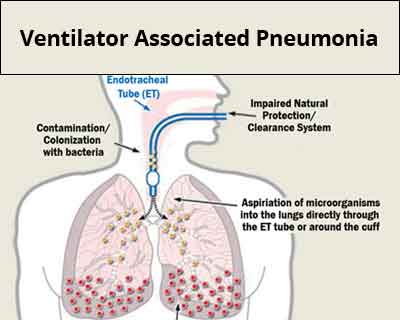- Home
- Editorial
- News
- Practice Guidelines
- Anesthesiology Guidelines
- Cancer Guidelines
- Cardiac Sciences Guidelines
- Critical Care Guidelines
- Dentistry Guidelines
- Dermatology Guidelines
- Diabetes and Endo Guidelines
- Diagnostics Guidelines
- ENT Guidelines
- Featured Practice Guidelines
- Gastroenterology Guidelines
- Geriatrics Guidelines
- Medicine Guidelines
- Nephrology Guidelines
- Neurosciences Guidelines
- Obs and Gynae Guidelines
- Ophthalmology Guidelines
- Orthopaedics Guidelines
- Paediatrics Guidelines
- Psychiatry Guidelines
- Pulmonology Guidelines
- Radiology Guidelines
- Surgery Guidelines
- Urology Guidelines
Preventing Ventilator Associated Pneumonia in hospitals - GOI Guidelines

Pneumonia is one of the three most common HCAIs. Patients who are mechanically ventilated are at risk for ventilator associated pneumonia (VAP).
Most bacterial nosocomial pneumonias occur by aspiration of bacteria colonizing the oropharynx or upper gastrointestinal tract of the patient. Intubation and mechanical ventilation greatly increase the risk of nosocomial bacterial pneumonia because they alter first-line patient defenses.
National Centre for Disease Control, MOHFW, Government of India, in their Hospital infection control and prevention guidelines cleary provide guidelines for prevention of VAP in a hospital setup. Its important that all these are adopted by all healthcare as well as allied professionals in their daily practise.
Prevention of VAP
- Adhere to hand-hygiene guidelines.
- Health-care worker should ear a mask and an apron or gown when anticipates soiling of respiratory secretions from a patient (e.g. intubation, tracheal suctioning, tracheostomy, and bronchoscopy) and change it after the procedure and before providing care to another patient.
- Elevate the head of the bed 30 – 45 degrees of a patient on mechanical ventilation or at high risk for aspiration (e.g. on oro or nasoenteral tube)
- Remove devices such as endotracheal, tracheostomy, oro/ nasogastric tubes from patients as soon as they are not indicated.
- Perform orotracheal rather than nasotracheal intubation unlesscontraindicated.
- Use non-invasive ventilation whenever possible.
- Perform daily assessments of readiness to wean and use weaning protocols.
- Avoid unplanned extubation and reintubation.
- Use a cuffed endotracheal tube with in-line or subglottic suctioning.
- Avoid histamine receptor blocking agents and proton pump inhibitors for patients who are not at high risk for developing a stress ulcer or stress gastritis.
- Perform regular oral care with an antiseptic solution.
- Avoid gastric overdistension.
- Remove condensate from ventilatory circuits. Keep the ventilatory circuit closed during condensate removal.
- Change the ventilatory circuit only when visibly soiled or malfunctioning.
- Store and disinfect respiratory therapy equipment properly.
- Educate healthcare workers who provide care for patients undergoing ventilation about VAP.
Develop a surveillance system to study the incidence of VAP
- Conduct active surveillance for VAP in units that care for patients undergoing ventilation who are known or suspected to be at high risk for VAP.
- Collect data that will support the identification of patients of VAP and calculation of VAP rates.
http://www.ncdc.gov.in/writereaddata/mainlinkfile/File571.pdf
Next Story
NO DATA FOUND

Disclaimer: This site is primarily intended for healthcare professionals. Any content/information on this website does not replace the advice of medical and/or health professionals and should not be construed as medical/diagnostic advice/endorsement or prescription. Use of this site is subject to our terms of use, privacy policy, advertisement policy. © 2020 Minerva Medical Treatment Pvt Ltd